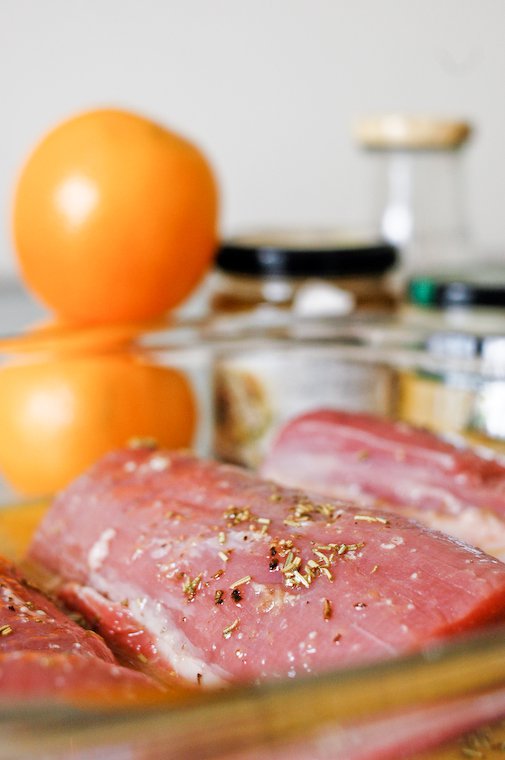Why is it that no one ever told me about the pork tenderloin?
Has everyone been cooking pork tenderloin all this time, licking their lips and giggling covertly as I fought to make other cuts palatable, trying my best to prevent them from turning out dry, and grey?
Oh, it’s not that I haven’t been happy with my pork experiments, not at all. Looking through the C&Z archives, I’ve found five recipes involving our pink friend — a cured pork shoulder with lentils, a loin blade roast stewed in cider, a roast with spiced red cabbage, and two terrines — that were all, if I remember correctly, consumed with unequivocal pleasure.
Pork does well with sweet and tangy flavors, so I opted for a simple marinade of orange juice, honey, and rosemary.
It’s just that, now that I’ve had a taste of filet mignon de porc — for such is the French name for it* — I wonder what took me so long: it is truly the most succulent, the most flavorsome cut of pork I’ve ever dealt with.
If you’re at all excited about the butcher’s craft, you may be interested to learn that the pork filet mignon (tenderloin) is a long muscle located on either side of the lower end of the animal’s spine (so each pork yields two), underneath the filet (sirloin) and the pointe de filet (the tail end of the sirloin). (And lest you assume I’ve become an overnight expert in butchery, let me note that my life changed when I acquired a Larousse gastronomique and laid eyes on its crystal-clear meat diagrams.)
The tenderloin is lean, and remarkably tender, so it is a choice cut that comes at a higher price than most: my organic butcher charges 19.50€/kg ($12/pound) for it, but it is net weight with no waste, i.e. no fat, bone, or gristle to remove.
Pork does well with sweet and tangy flavors, so I opted for a simple marinade of orange juice, honey, and rosemary, which, reduced and creamed up while the tenderloin was roasting in the oven, made for the perfect sauce to ladle over the butter-tender slices of meat.
~~~
* In French butchery, the term filet mignon is used not only for beef, but also for veal, venison, and pork. It refers to the same muscle in all cases, insofar as muscular similarities can be found in these different animals.

Have you tried this? Share your pics on Instagram!
Please tag your pictures with #cnzrecipes. I'll share my favorites!
Ingredients
- 800 grams (1 pound 12 ounces) pork tenderloin (filet mignon in French), preferably organic
- the juice of two oranges
- 2 tablespoons olive oil
- 1 tablespoon white wine vinegar
- 1 rounded teaspoon honey
- 2 cloves garlic, finely chopped
- 1 teaspoon dried rosemary
- 1/4 teaspoon fine sea salt
- freshly ground black pepper
- 1 rounded tablespoon crème fraîche, or heavy cream
- fleur de sel
- a handful flat-leaf parsley, coarsely chopped
Instructions
- Cut the tenderloin in 3 or 4 equal portions and place them in a nonreactive (glass or ceramic) baking dish large enough to accomodate them in a single layer.
- Whisk together the marinade ingredients and pour them over the meat. Cover and refrigerate for at least an hour, and up to 4 hours, flipping the pieces of meat regularly so they'll marinate evenly.
- Remove the dish from the fridge and preheat the oven to 180°C (360°F). Pour most of the marinade into a small saucepan, and leave about a tablespoon in the dish.
- Put the dish (uncovered) in the oven and roast for 25 minutes, until cooked through but not dried out (the meat should be pale pink in the center; if using a meat thermometer, the recommended safe internal temperature is 70°C or 160°F), flipping the meat a couple of times during the roasting and basting it with its juices. Switch to grill and cook for 5 more minutes, until golden and slightly crusty at the top.
- While the meat is roasting, put the saucepan with the remaining marinade over medium-high heat and bring to a boil. Keep boiling, uncovered, stirring regularly, until the marinade has reduced to a thick syrup and is about a quarter of its original volume. Remove from heat, add in the cream, stir, and keep warm.
- When the meat is ready, remove the dish from the oven, and transfer the meat to a cutting board. Add the marinade and cream mixture to the dish and stir to combine with the cooking juices. Cut the meat pieces into thickish slices, return to the dish, and sprinkle with fleur de sel and parsley. Bring the dish to the table and serve immediately, with boiled or mashed potatoes, and/or sautéed carrots.














